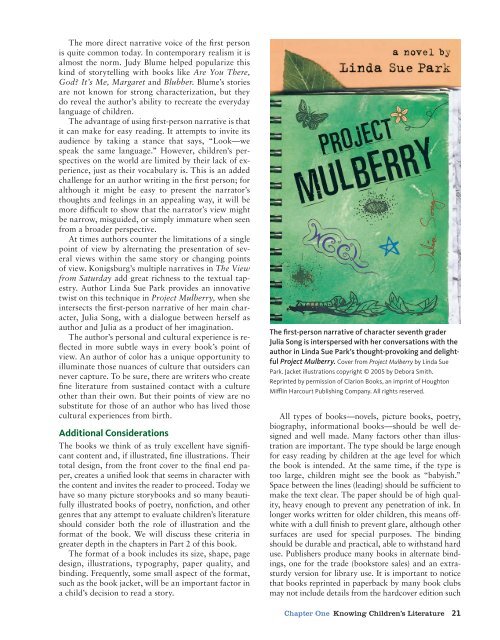Learning About Books and Children
Learning About Books and Children
Learning About Books and Children
Create successful ePaper yourself
Turn your PDF publications into a flip-book with our unique Google optimized e-Paper software.
The more direct narrative voice of the fi rst person<br />
is quite common today. In contemporary realism it is<br />
almost the norm. Judy Blume helped popularize this<br />
kind of storytelling with books like Are You There,<br />
God? It’s Me, Margaret <strong>and</strong> Blubber. Blume’s stories<br />
are not known for strong characterization, but they<br />
do reveal the author’s ability to recreate the everyday<br />
language of children.<br />
The advantage of using fi rst-person narrative is that<br />
it can make for easy reading. It attempts to invite its<br />
au dience by taking a stance that says, “Look—we<br />
speak the same language.” However, children’s perspectives<br />
on the world are limited by their lack of experience,<br />
just as their vocabulary is. This is an added<br />
challenge for an author writing in the fi rst person; for<br />
al though it might be easy to present the narrator’s<br />
thoughts <strong>and</strong> feelings in an appealing way, it will be<br />
more diffi cult to show that the narrator’s view might<br />
be narrow, misguided, or simply immature when seen<br />
from a broader perspective.<br />
At times authors counter the limitations of a single<br />
point of view by alternating the presentation of several<br />
views within the same story or changing points<br />
of view. Konigsburg’s multiple narratives in The View<br />
from Sat urday add great richness to the textual tapestry.<br />
Author Linda Sue Park provides an innovative<br />
twist on this technique in Project Mulberry, when she<br />
intersects the fi rst-person narrative of her main character,<br />
Julia Song, with a dialogue between herself as<br />
author <strong>and</strong> Julia as a product of her imagination.<br />
The author’s personal <strong>and</strong> cultural experience is refl<br />
ected in more subtle ways in every book’s point of<br />
view. An author of color has a unique opportunity to<br />
illuminate those nuances of culture that outsiders can<br />
never capture. To be sure, there are writers who create<br />
fi ne literature from sustained contact with a culture<br />
other than their own. But their points of view are no<br />
substitute for those of an author who has lived those<br />
cultural experiences from birth.<br />
Additional Considerations<br />
The books we think of as truly excellent have signifi -<br />
cant content <strong>and</strong>, if illustrated, fi ne illustrations. Their<br />
total design, from the front cover to the fi nal end paper,<br />
creates a unifi ed look that seems in character with<br />
the content <strong>and</strong> invites the reader to proceed. Today we<br />
have so many picture storybooks <strong>and</strong> so many beautifully<br />
illustrated books of poetry, nonfi ction, <strong>and</strong> other<br />
genres that any attempt to evaluate children’s literature<br />
should consider both the role of illustration <strong>and</strong> the<br />
format of the book. We will discuss these criteria in<br />
greater depth in the chapters in Part 2 of this book.<br />
The format of a book includes its size, shape, page<br />
design, illustrations, typography, paper quality, <strong>and</strong><br />
binding. Frequently, some small aspect of the format,<br />
such as the book jacket, will be an important factor in<br />
a child’s decision to read a story.<br />
The fi rst-person narrative of character seventh grader<br />
Julia Song is interspersed with her conversations with the<br />
author in Linda Sue Park’s thought-provoking <strong>and</strong> delightful<br />
Project Mulberry. Cover from Project Mulberry by Linda Sue<br />
Park. Jacket illustrations copyright © 2005 by Debora Smith.<br />
Reprinted by permission of Clarion <strong>Books</strong>, an imprint of Houghton<br />
Miffl in Harcourt Publishing Company. All rights reserved.<br />
All types of books—novels, picture books, poetry,<br />
bi og raphy, informational books—should be well designed<br />
<strong>and</strong> well made. Many factors other than illustration<br />
are important. The type should be large enough<br />
for easy reading by children at the age level for which<br />
the book is intended. At the same time, if the type is<br />
too large, children might see the book as “babyish.”<br />
Space between the lines (leading) should be suffi cient to<br />
make the text clear. The paper should be of high quality,<br />
heavy enough to prevent any penetration of ink. In<br />
longer works written for older children, this means offwhite<br />
with a dull fi nish to prevent glare, although other<br />
surfaces are used for special purposes. The binding<br />
should be durable <strong>and</strong> practical, able to withst<strong>and</strong> hard<br />
use. Publishers produce many books in alternate bindings,<br />
one for the trade (bookstore sales) <strong>and</strong> an extrasturdy<br />
version for library use. It is important to notice<br />
that books reprinted in paperback by many book clubs<br />
may not include de tails from the hardcover edition such<br />
Chapter One Knowing <strong>Children</strong>’s Literature 21

















